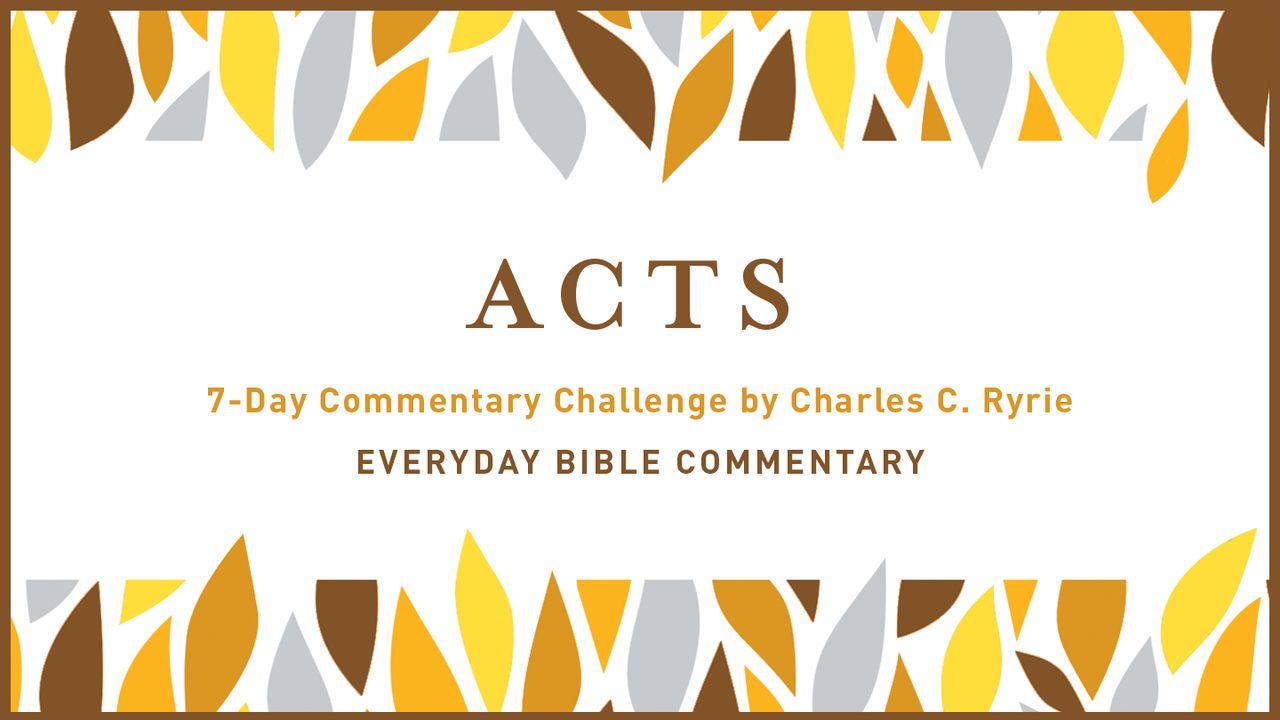7-Day Commentary Challenge - Acts 1-3 Sample

The Sermon, 2:14–36
As spokesman for the Twelve, Peter seized the opportunity, afforded by the charge of drunkenness leveled at the disciples, to preach Jesus to the crowd.
1. Introduction—explanation, 2:14–21. The message began with an explanation of the phenomena. It could not be drunkenness since it was only nine o’clock in the morning, and Jews engaged in the exercises of the synagogue on a feast day abstained from eating and drinking until 10 a.m. or even noon. It was not intoxication, Peter said; it was the ministry of the Spirit that caused the spectacle. To prove that the Spirit can produce such things, Peter quoted from Joel 2:28–32. This is a prophecy that will be fulfilled during the millennium when Israel is reestablished in her own land. Peter was not saying that the prophecy was fulfilled at Pentecost or even that it was partially fulfilled; knowing from Joel what the Spirit could do, he was simply reminding the Jews that they should have recognized what they were then seeing as a work of the Spirit also. He continued to quote from Joel at length only in order to be able to include the salvation invitation recorded in verse 21.
2. Theme—Jesus is Messiah, 2:22–35. To the English reader it means little to say that Jesus is Messiah or Christ. Jesus Christ to us, is in the nature of first and last names, but to the Jews, Christ or Messiah was a well-defined concept from their Old Testament Scriptures, and Jesus of Nazareth was to many merely another upstart human, religious teacher. To say that Jesus was the Christ was blasphemy. Thus Peter sought to prove to his audience that Jesus of Nazareth, whom they knew well, was their Messiah, whom they also knew well. From Old Testament prophecies Peter reminded them of the picture of Messiah. From contemporary facts, he painted a picture of Jesus. He superimposed these two pictures on each other to prove that Jesus is Christ, and the focal point of his entire argument was the resurrection.
First he proclaimed the resurrection of Jesus (vv. 22–24). Then he recalled the predictions of the resurrection from Psalm 16:8–11 (vv. 25–31). He showed that it was not David who was raised since he was still in a tomb; therefore, David must have been speaking about someone else, namely Messiah. “He looked ahead and spoke of the resurrection of the Christ” (v. 31a). Having proclaimed the resurrection of Jesus and having shown that Messiah had to be raised, Peter then reinforced his argument by citing proofs of the resurrection of Jesus (vv. 32–36). He reminded them that they were eyewitnesses of that miracle (v. 32), and we should remember that he was speaking to many residents of the city in which the resurrection had taken place less than two months before. Second, he cited the exaltation of Jesus at the right hand of God (vv. 33–35). This answered, in the negative, two questions: “Can a mere man occupy that place of honor?” and, “Can a dead man be exalted?” The third proof of the resurrection was the outpouring of the Holy Spirit—something no mere man, and certainly not a dead man, could do (vv. 33–35).
3. Conclusion—Application, 2:36. The pictures of Messiah and Jesus of Nazareth coincided. The proof of Jesus’ resurrection was incontrovertible. Then Peter put it squarely to his audience to decide the truth of his message.
Scripture
About this Plan

This commentary challenge is taken from the Everyday Bible Commentary on Acts 1-3, focusing on birth of the Church through the power of the Holy Spirit. This plan is for anyone who desires to deepen their study of Scripture and begin to discover the profound moving of the Spirit in the early Church.
More
Related plans

IHCC Daily Bible Reading Plan - December

The Renewal You Need at Christmas

Pieces of Manna: Surviving Your Wilderness Season

Content With Discontent: Killing Comparison With Gratitude

The 3 Wise Women of Christmas

What Is the Church?

Praying and Waiting for Christmas: A 7 Day Advent Devotional

Leading God's Way: Wisdom for Nonprofit Board Governance

Christmas in a Season of Struggle
